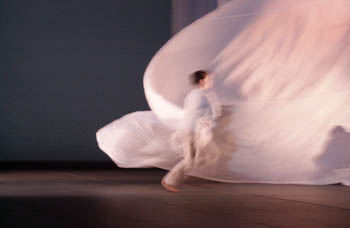![[Metroactive Arts]](/arts/gifs/art468.gif)
[ Arts Index | Santa Cruz Week | SantaCruz Home | Archives ]
Flowetry in Motion: The Trisha Brown Dance Company performs Wednesday, Feb. 23, at the Mello Center in Watsonville.
Anti-Gravity
For Trisha Brown's dance company, Newton's universal law is more like a suggestion--and they've politely declined
By Peter Koht
The laws of gravity are a harsh mistress whose unrelenting grasp on all our bodies only grows worse with each passing year. Though most dancers tend to bend these Newtonian axioms with ease, Trisha Brown and her company were the first to fully cast off the shackles of Sir Isaac and his damn apples.
Beginning around 1976, Brown and her company began walking up the walls. "It grew out of wanting to establish a dialogue with gravity," Brown says.
"Initially we worked them out in the studio with materials that we bought from the hardware store. God, did those rigs hurt my feet."
Defying gravity is not the only innovation that Brown has been a part of during her illustrious career. Over the course of 30 years in the dancing game, she has built up a repertoire of amazing work and revolutionized the way that audiences perceive modern dance. But climbing up the walls plays a significant role in her upcoming performance at the Mello Center on Feb. 23. One of the centerpieces of the program is called "Present Tense" and is based on John Cage's Sonatas and Interludes.
Initially born out of Cage's experiments with prepared piano at Cornish School in 1940, the music was composed with dancers in mind. Although Cage was initially commissioned to write percussion music, the dance studio at Cornish only had a grand piano, so Cage began inserting whatever objects he could find into the strings to make the piano mimic the missing percussion orchestra. But Trisha Brown chose the piece more out of necessity than historical awareness.
"I was working with a Schubert song cycle with a singer and the singer needed every other evening off, so I searched for the best piano music that I could possibly find. That just happened to be the Sonatas and Interludes."
Brown's relationship with Cage's music predates the founding of her own company. "I met Cage when I was very young," she says. "I went out to hear him give a lecture at Connecticut College on indeterminacy. When I heard him talk about the relationship of form to the subject matter in composition, I just lifted off my chair. Here was someone who had gotten it."
The true centerpiece of the program however is a new choreography: "Groove and Countermove," whose music was provided by trumpeter Dave Douglas. At nearly 90 minutes, it's an intense musical and physiological workout.
Brown recalls the compositional challenges of working with Douglas' score. "Dave's music is so vibrant and aggressive at times that the dancers are chasing the music. The first portion is choreographed out of these algorithmic
improvisation patterns that I gave my dancers. They are asymmetrical and reflect the kind of motions that are happening in the music."
"For the last section of the piece, I took some patterns that the dancers had come up with earlier, edited out all the traveling phrases and condensed them into the final motions of the dance. So throughout the whole piece the choreography rises and grows ever stronger and higher."
So strong in fact that the dancers let slip the shackles of gravity and soar above the lowly ground.
Copyright © Metro Publishing Inc. Maintained by Boulevards New Media.
For more information about Santa Cruz, visit santacruz.com.
![]()

Photograph by Marc Ginot
UCSC Arts & Lectures presents the Trisha Brown Dance Co. performing 'Present Tense' Wednesday, Feb. 23, at 8pm at the Henry J. Mello Center, 250 E. Beach St., Watsonville. Tickets $23/$27 adults, $23/students and seniors with ID, $15 UCSC students with ID. Call 831.459.2159 for tickets.
From the February 23-March 2, 2005 issue of Metro Santa Cruz.